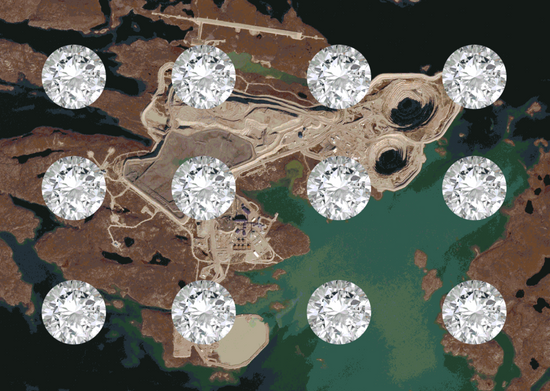Much of the global diamond supply has been mined to the detriment of human rights and the environment. The industry has fuelled exploitative and unsafe working conditions, child labour, war crimes, ecological devastation and forcible displacement. Incongruously, diamonds have become a symbol of love. At Lylie’s Sustainable Jewellery, we want the story behind them to match.
Modern Day Slavery
Human Rights Watch has found the industry accountable for numerous cases of bonded labour, physical, and sexual violence and dangerous working conditions. 15% of the diamond industry is characterised by a large informal sector without labour standards. It has become a breeding ground for middlemen who recruit miners to work in lieu of debt or who purchase the diamonds from the miners at pitiful prices. The work itself is backbreaking with gruellingly long hours and the danger of mudslides, mine collapses or defective equipment a daily risk. The wealth accumulated by a country’s diamond industry rarely reaches the wider population. In Africa roughly a million diamond miners earn less than one dollar a day.
Further information: Article One, Article Two & Article Three
Child Labour
Globally, there is an estimated one million children aged 5-17 working in small scale mines. Children, driven to work by necessity, are seen as an attractive pool of labour because of their cheap wages and infantile bodies that can access narrow and dangerous mineshafts. Growing demands and burdens of work mean that many children sacrifice their education, condemning them to a life in the mines. A report by Swedwatch in the Democratic Republic of Congo found that rape, forced marriage and prostitution were a common story for young girls living in mining towns.
Further information: Article One, Article Two & Article Three
Environmental Harm
Having taken millions of years to form, diamonds are either extracted miles beneath the earth’s surface via pipe mining or from riverbeds and ocean beds via alluvial mining. It takes the excavation of roughly 1,700 tons of earth to find just one carat of rough diamond. The result: mass deforestation, soil erosion and wildlife displacement. Abandoned mining pits full of dirty water become hotbeds for mosquitos and their diseases. Alluvial mining pollutes the water and destroys all wildlife in its wake. Additionally, the environmental harm impacts nearby inhabitants, often indigenous communities reliant on the local ecosystem.
Further information: Article One, Article Two & Article Three
Armed Conflicts
Exercising violence, torture and rape, warlords in Western and Central Africa have historically enslaved mining towns and used diamond profits to intensify conflict. These diamonds, labelled blood or conflict diamonds, have ended up in the global market. In 2003, the Kimberly Process formed with the aim of preventing their sale. Under this scheme, participating countries and trading organisations must declare their diamonds conflict free and enter an exclusive trading agreement. However, its definition of a conflict diamond only covers diamonds supporting anti-government armed militia; a loophole that enabled the Zimbabwe government to sell diamonds from a state-owned mine found guilty of using forced labour, child labour and violence.
Further information: Article One, Article Two & Article Three
So, What about 'Ethical Diamonds'?
As is often wrongly assumed, a conflict free diamond does not equate to a diamond free from human rights abuses and environmental harm. The Kimberly Process fails to consider the numerous other human rights violations that occur. Many jewellers do advertise ethically and environmentally sourced diamonds. However, between mining them and wearing them, diamonds pass countless hands making traceability near impossible. The opportunity for corrupt diamonds to enter the supply chain is substantial.
Further information: Article One & Article Two
At Lylie’s Sustainable Jewellery, we believe that the beauty of a stone cannot be divorced from the source. There is no beauty in cruelty. To avoid any doubt over sourcing, we exclusively use manmade diamonds (indistinguishable from natural ones) or antique recycled diamonds. More info here.
Words
Caitlin Astley
Images
Danae Papazymouri












